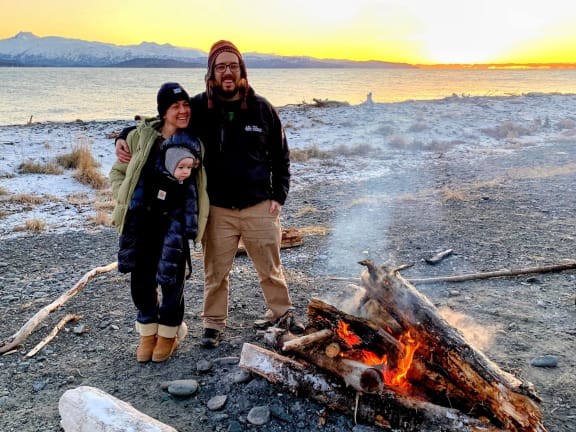When my husband Arron (WAC founder + CEO) first started bringing me to Homer, his home town in rural Alaska, I quickly learned that one of his favorite things to do in this cosmic hamlet by the sea (which is how it's often called) is make beach fires. Admittedly, at first I didn't get it and would ask myself a litany of questions when he'd propose said plan: What's the point? Isn't it too much work for nothing? Make a fire… and do what?
But after many seasons in Alaska with Arron, I'd come to discover that time works in its own way there, and that the simple act of making a fire is a way to stop and uniquely punctuate moments in our lives. A way to encapsulate slivers of our trajectories with the light, warmth, and sense of security that a bonfire inevitably fosters. A way to illuminate the power of community, the joy of togetherness, and the elemental pleasure of being united as one.
For Arron, beach fires always meant that the grind of day-to-day life would come to a momentary halt, and folks from every generation, from elder to babe, would gather around in this special and unofficial ritual of intentional alchemy. One in which flames appear and daily stressors diminish. In which darkness is brightened with that distinct orange-yellow luminescence, and the snap and crackle of wood and ember craft a syncopated dialogue between earth and sky.
As my husband says, "The bonfire was the original dinner table," to which I would add, “The first stove and oven, too.” Thanks to fire, for thousands of generations humans have been privy to the primal shared experience of not only cooking in community, but also breaking bread together in the magnificent light of that blaze. And it's not simply the benefits of the fire that make it special — the work it takes to start and then put out a fire is equally laden with a sense of reward, an eventual gratification that arrives with that first spark of achievement.
I also enjoyed learning that one of the things Alaskans did in the mid-’50s to celebrate their impending statehood was, you guessed it, rally around a bonfire. As LIFE magazine writes, "In Anchorage residents danced, built a massive bonfire and raced around it on horseback.”
And for the past 20 years there has also been Homer’s Burning Basket, inspired by like-minded festivals on the west coast, during which effigies are burned as communal rituals. As the Homer News tells it, the tradition, which was ignited (literally!) by Homer artist Mavis Muller in 2004, is “a community-wide collaboration that brings to life a Basket of Remembrance & Unburdening … Once the basket is decorated, it is offered as a gift to the community, with everyone invited to write and place personal messages on and within the basket. At sundown, with drummers drumming and fire performers performing, community members form a circle around the basket a safe distance away, as volunteers light torches and place them beneath the basket. Cracking and hissing, with embers soaring upwards, the basket burns to ash, a symbol of the impermanent nature of life.”
For all Alaskans, one thing is certain: this ancient ritual is as alive and significant today as it always has been. An activity that centers us around what matters most, reminding us to slow down and pay attention — to the world around us, and to one another.
As we draw closer to the warmth of summer, many of us will find ourselves gathering around our own little fires — modest campfires, raucous beach bonfires, suburban fire pits, weekend cookouts. I invite you to acknowledge and celebrate the magic of fire, the special role it plays in our lives, and the wondrous way in which it transforms meals into memories.
Live Wild!
Monica
Pictured above: A sweet capture of one of the first beach fires we ever made as a new family, on the shores of Kachemak Bay, where my husband Arron grew up running with the whales and floating around on icebergs.






